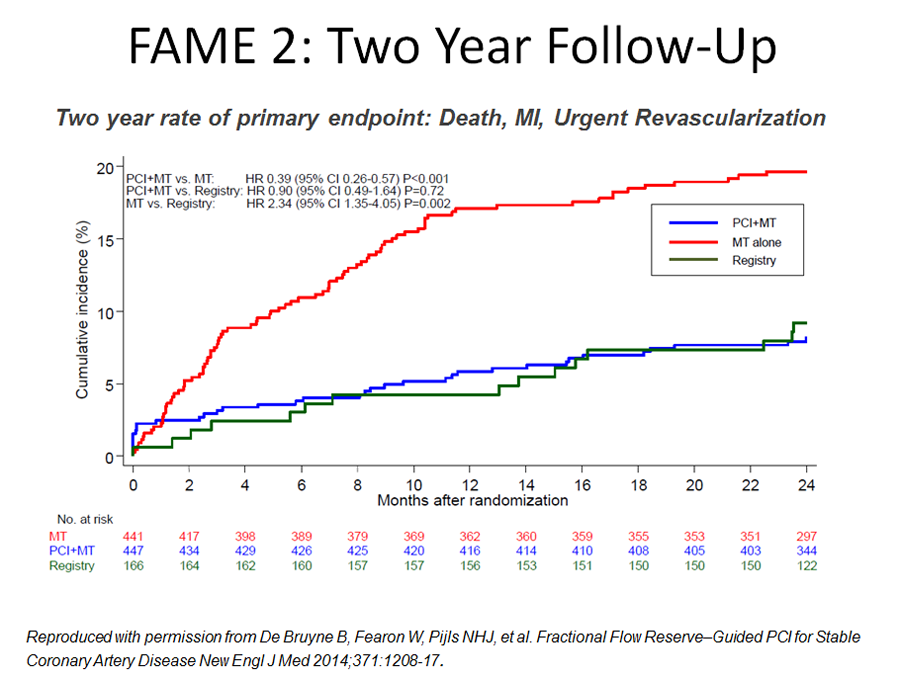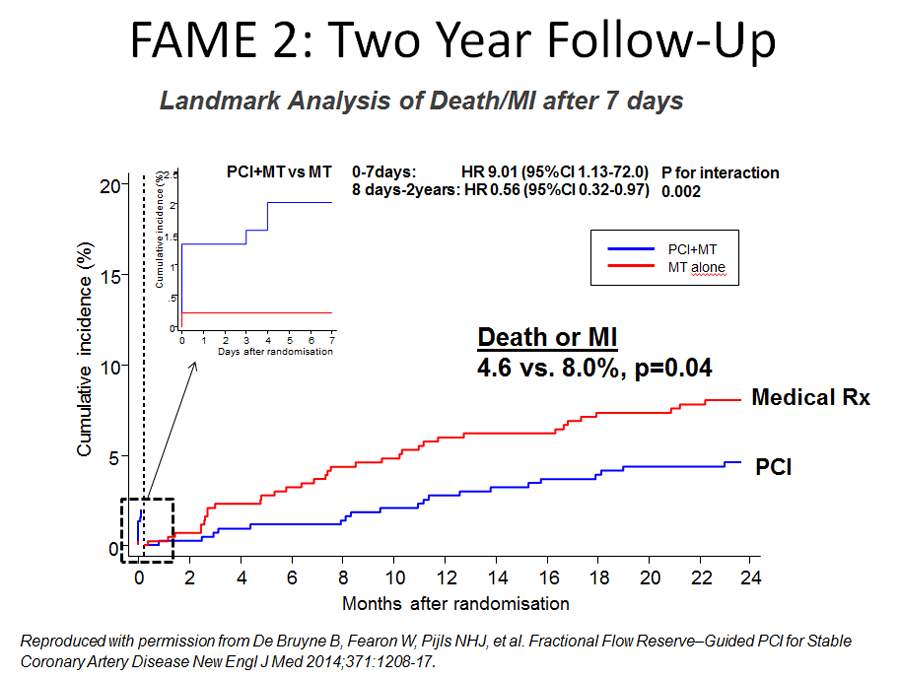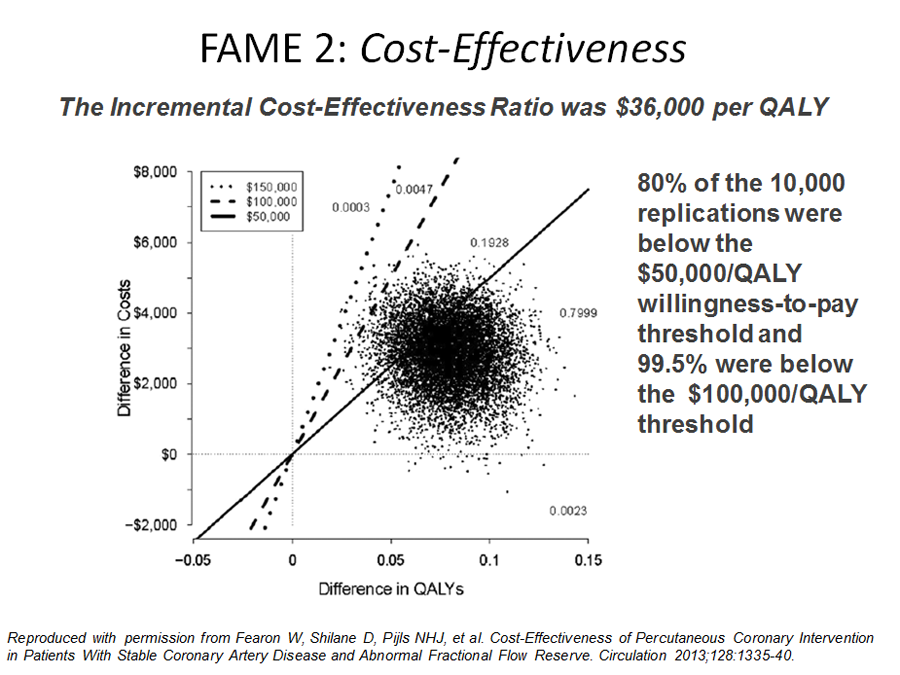The Current Role of Fractional Flow Reserve in the Treatment of Patients With Stable Ischemic Heart Disease
Myocardial ischemia as a result of epicardial coronary artery stenosis is the most common cause of stable angina pectoris and is associated with adverse outcomes. Stress testing and noninvasive coronary imaging aid in the diagnosis of ischemia, and invasive coronary angiography can confirm the presence of epicardial stenosis. Anti-anginal medical therapy with or without revascularization, either percutaneous coronary intervention (PCI) or coronary artery bypass graft surgery (CABG) is the main therapeutic strategy in patients with stable ischemic heart disease (SIHD). Correlating the noninvasive data with the coronary angiographic findings can be challenging, particularly in patients with multivessel coronary artery disease (CAD). Moreover, determining which coronary lesion is responsible for ischemia, based on the angiographic findings alone is inaccurate when the diameter stenosis is between 30 and 90%. Measuring fractional flow reserve (FFR) with a coronary pressure wire allows the interventional cardiologist to identify which specific lesion(s) is responsible for the ischemia and leads to improved outcomes when used to guide the decision regarding the need for PCI or CABG.
Numerous studies have demonstrated the safety of deferring PCI in patients with SIHD and epicardial stenoses, as long as the FFR is in the non-ischemic range. For example, in the multicenter, randomized DEFER trial patients with SIHD and intermediate lesions in which the FFR was above the ischemic threshold were randomized to undergoing PCI anyway or to medical management. Five year follow-up showed that medical therapy was just as effective at preventing subsequent adverse events with a rate of cardiac death and myocardial infarction that was less than half of what it was in the PCI arm.1 More recently, the FFR versus Angiography for Multivessel Evaluation (FAME) trial highlighted the very low event rate at two years in patients with multivessel CAD who had PCI of angiographically significant lesions deferred because the FFR was not in the ischemic zone.2 The FAME trial is important because it also showed that FFR-guide PCI is superior to angiography-guided PCI, resulting in lower rates of death and myocardial infarction.3
The most recent study documenting the role of FFR in managing patients with SIHD is the FAME 2 trial, which compared PCI to best medical therapy in a multicenter, randomized fashion.4 In this study, patients with SIHD first had FFR measured, and only if the FFR was abnormal was the patient randomized; this ensured that only patients with significant myocardial ischemia were included. Of note, about ¼ of the patients who were otherwise eligible for the study, having at least one stenosis >50% on angiography which was amenable to PCI, were found to have no significant ischemia based on FFR and were therefore included in a registry. We know from the previous studies mentioned that outcomes in these patients are as good if not better when treated with medical therapy alone compared to PCI. Inclusion of these registry patients in the randomized study would only dilute any potential benefit of PCI and may explain in part the neutral results in previous trials comparing PCI to medical therapy in SIHD patients.
|
|
At two years, patients in the FAME 2 trial treated with PCI had a significantly lower rate of the composite endpoint of death, myocardial infarction and the need for hospitalization with urgent revascularization.5 This difference was driven primarily by the lower rate of urgent revascularization in the PCI arm, although there was a 20% reduction in death and myocardial infarction, which alone was not statistically significant. However, a landmark analysis comparing death and myocardial infarction after seven days, which effectively eliminates the periprocedural myocardial infarctions in the PCI arm and only accounts for spontaneous death and myocardial infarction during follow-up, showed a significantly higher rate in the medical therapy group. This may be relevant because spontaneous myocardial infarction has been shown to be a stronger predictor of subsequent mortality when compared to periprocedural myocardial infarction. Importantly, patients who underwent PCI also had superior angina relief and quality of life. This translated into an attractive incremental cost-effectiveness ratio of $36,000 per quality adjusted life years for the PCI arm.6 Finally, those patients in the registry who had CAD but no significant ischemia had an excellent outcome with medical therapy alone. Limitations of this study included that enrolment was stopped early by the data safety monitoring board because of the significantly higher event rate in the medical therapy arm, the lack of blinding of the physicians or patients, and the fact that the study was not powered to evaluate differences in death and myocardial infarction alone.
In conclusion, measurement of FFR in patients with SIHD identifies those patients with significant myocardial ischemia who will benefit from PCI by having improved symptom relief and lower rates of hospitalization for urgent revascularization when compared to medical therapy alone. Importantly, patients with SIHD who have no significant ischemia based on FFR have an excellent outcome with medical therapy alone.
References
- Pijls NHJ, van Schaardenburgh P, Manoharan G, Boersma E, Bech JW, van't Veer M, Bär F, Hoorntje J, Koolen J, Wijns W, De Bruyne B. Percutaneous Coronary Intervention of Functionally Non-significant Stenosis: 5-Year Follow-Up of the DEFER Study. J Am Coll Cardiol 2007;49:2105-2111.
- Pijls NH, Fearon WF, Tonino PA, Siebert U, Ikeno F, Bornschein B, van't Veer M, Klauss V, Manoharan G, Engstrøm T, Oldroyd KG, Ver Lee PN, MacCarthy PA, De Bruyne B; FAME Study Investigators.Fractional flow reserve versus angiography for guiding percutaneous coronary intervention in patients with multivessel coronary artery disease: 2-year follow-up of the FAME (Fractional Flow Reserve Versus Angiography for Multivessel Evaluation) study. J Am Coll Cardiol 2010;56:177-84.
- Tonino PAL, De Bruyne B, Pijls NHJ, Siebert U, Ikeno F, van't Veer M, Klauss V, Manoharan G, Engstrom T, Oldroyd KG, Ver Lee PN, MacCarthy PA, Fearon WF. Fractional flow reserve versus angiography for guiding percutaneous coronary intervention in patients with multivessel coronary artery disease. New Engl J Med 2009;360:213-24.
- De Bruyne B, Pijls NH, Kalesan B, Barbato E, Tonino PA, Piroth Z, Jagic N, Mobius-Winckler S, Rioufol G, Witt N, Kala P, MacCarthy P, Engström T, Oldroyd KG, Mavromatis K, Manoharan G, Verlee P, Frobert O, Curzen N, Johnson JB, Jüni P, Fearon WF; FAME 2 Trial Investigators. Fractional flow reserve-guided PCI versus medical therapy in stable coronary disease. N Engl J Med 2012;367:991-1001.
- De Bruyne B, Fearon WF, Pijls NH, Barbato E, Tonino P, Piroth Z, Jagic N, Mobius-Winckler S, Riouffol G, Witt N, Kala P, MacCarthy P, Engström T, Oldroyd K, Mavromatis K, Manoharan G, Verlee P, Frobert O, Curzen N, Johnson JB, Limacher A, Nüesch E, Jüni P; the FAME 2 Trial Investigators. Fractional Flow Reserve-Guided PCI for Stable Coronary Artery Disease. N Engl J Med 2014;371:1208-1217.
- Fearon WF, Shilane D, Pijls NH, Boothroyd DB, Tonino PA, Barbato E, Jüni P, De Bruyne B, Hlatky MA; Fractional Flow Reserve Versus Angiography for Multivessel Evaluation 2 (FAME 2) Investigators. Cost-effectiveness of percutaneous coronary intervention in patients with stable coronary artery disease and abnormal fractional flow reserve. Circulation 2013;128:1335-40.
Keywords: Angina Pectoris, Angina, Stable, Arm, Clinical Trials Data Monitoring Committees, Constriction, Pathologic, Coronary Angiography, Coronary Artery Bypass, Coronary Artery Disease, Coronary Disease, Coronary Stenosis, Follow-Up Studies, Hospitalization, Humans, Myocardial Infarction, Percutaneous Coronary Intervention, Quality of Life, Quality-Adjusted Life Years, Registries, Angina, Stable
< Back to Listings



